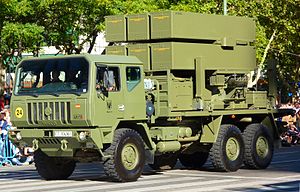
Spanish NASAMS 2 launcher vehicle during a military parade in Spain
The Norwegian Advanced Surface-to-Air Missile System 2 (abbreviated NASAMS 2) is a module-based, distributed and networked medium range air-defence system, designed by the Norwegian Kongsberg Gruppen. NASAMS 2 is an upgraded version of the NASAMS air-defence system and it has been operational since 2007.
A complete NASAMS 2 battery consists of 12 missile launchers (LCHR) (each one carrying six AMRAAM missiles), eight radars (AN/MPQ64 Sentinel), one fire control centre (CTOC), one electro-optical camera vehicle (MSP500) and one Tactical Control Cell (TCC) vehicle.
The upgrades consists of:
- New radars, which can be mounted on a variety of vehicles. The radars have their own power supply and can process and distribute the data independently. The vehicles can be connected via radio links, cable, through Multi Rolle Radio, or through TADKOM.
- The radars have a broader frequency spectrum and variable rotation speeds, and also an increased capacity to spot and follow targets.
- Each module can automatically determine its position with its northfinder and GPS instruments.
- The control centre modules can be mounted on a large variety of vehicles
- The electro-optical MSP500 sensor is equipped with a laser range finder and a TV-camera, as well as an upgraded IR-camera. These can be used to fire the missiles passively, which has been successfully tested.
The control system can detach itself from the sensors, in order to become less visible.
Operators[]
 Azerbaijan NASAMS [1]
Azerbaijan NASAMS [1] Finland NASAMS 2 (ordered)
Finland NASAMS 2 (ordered)Netherlands NASAMS 2
Norway NASAMS 2
 Spain NASAMS (1) first version
Spain NASAMS (1) first version- United States NASAMS (1) first version
 Chile NASAMS 2 (ordered)
Chile NASAMS 2 (ordered)
Reflist[]
The original article can be found at NASAMS 2 and the edit history here.